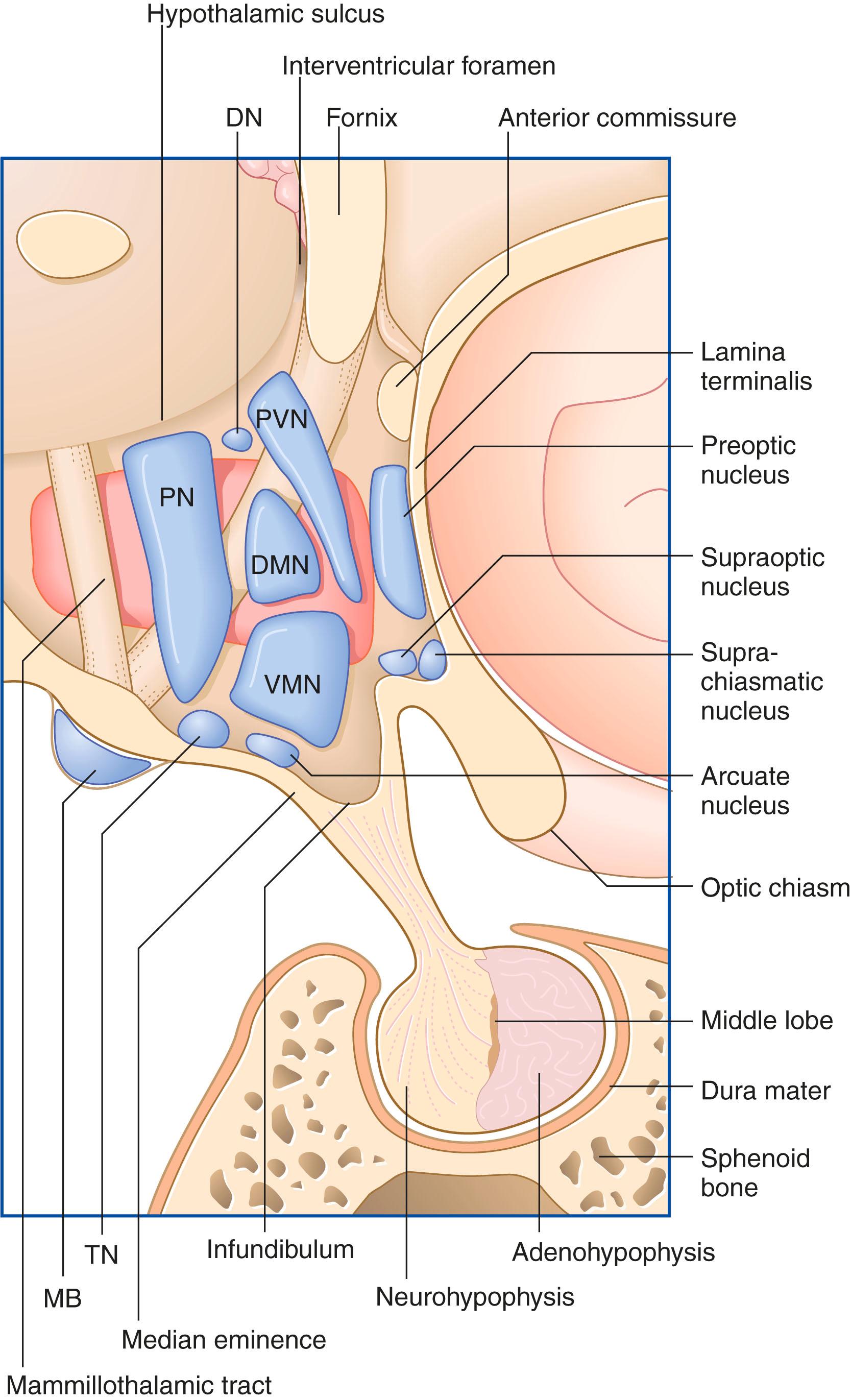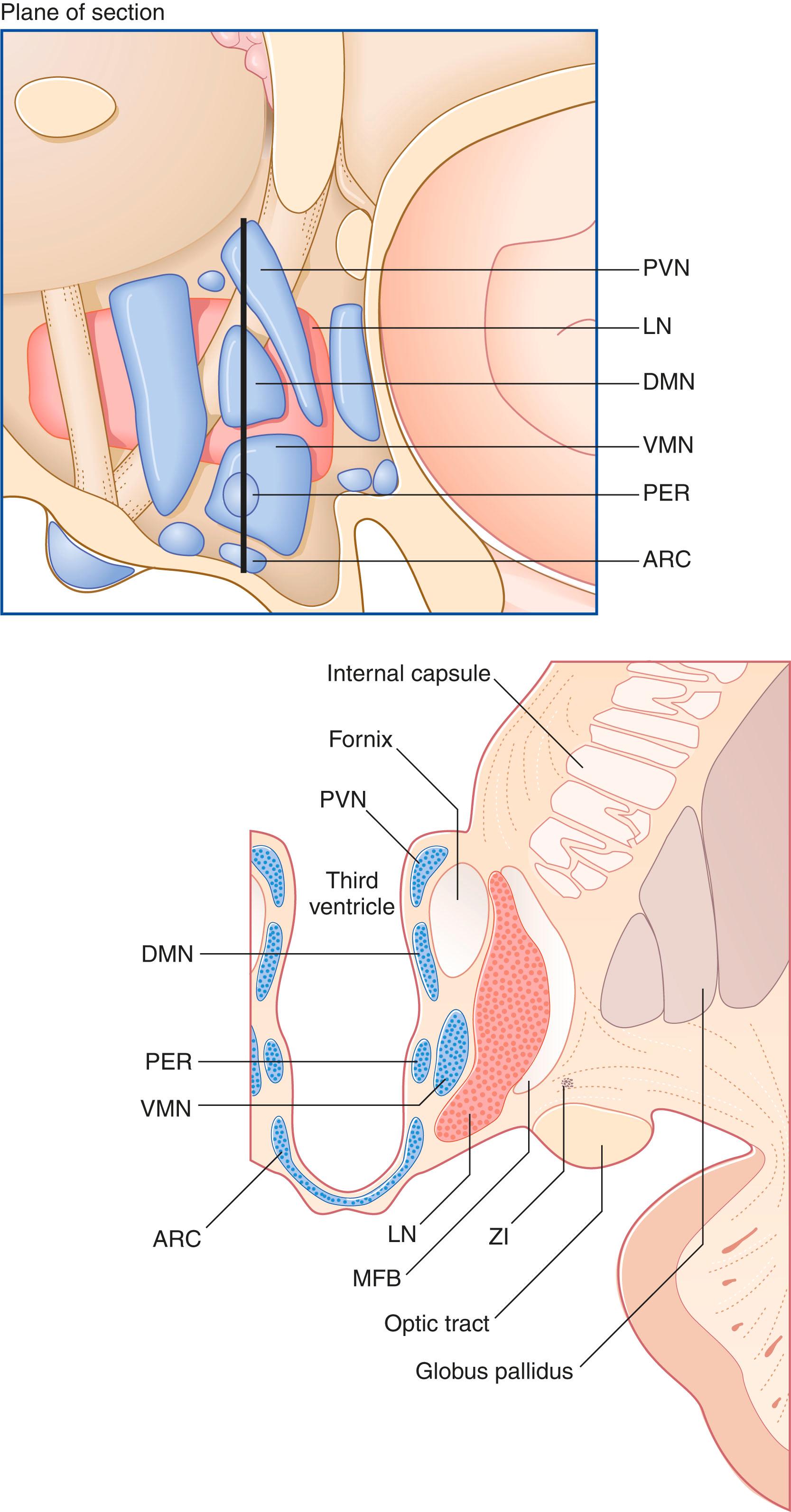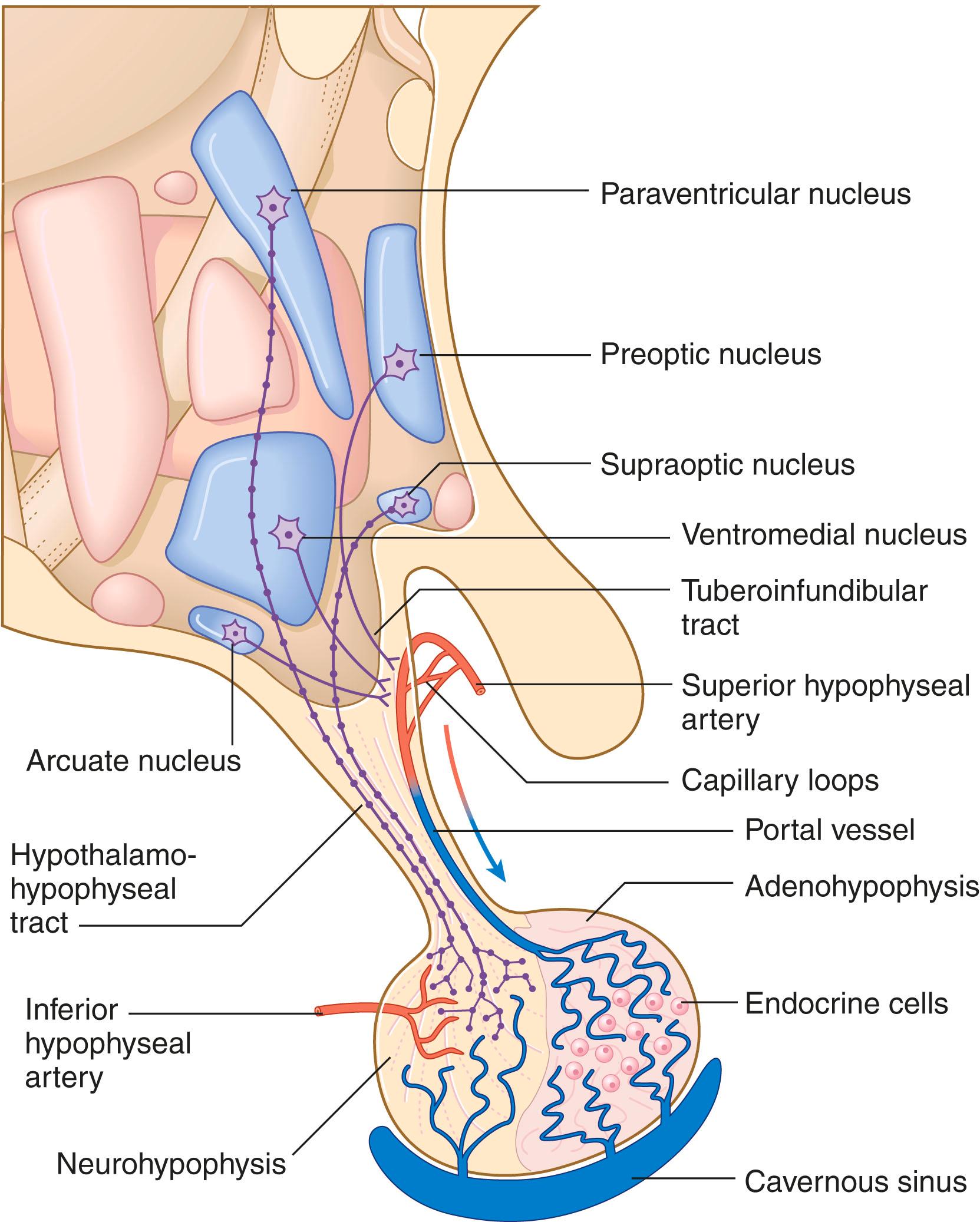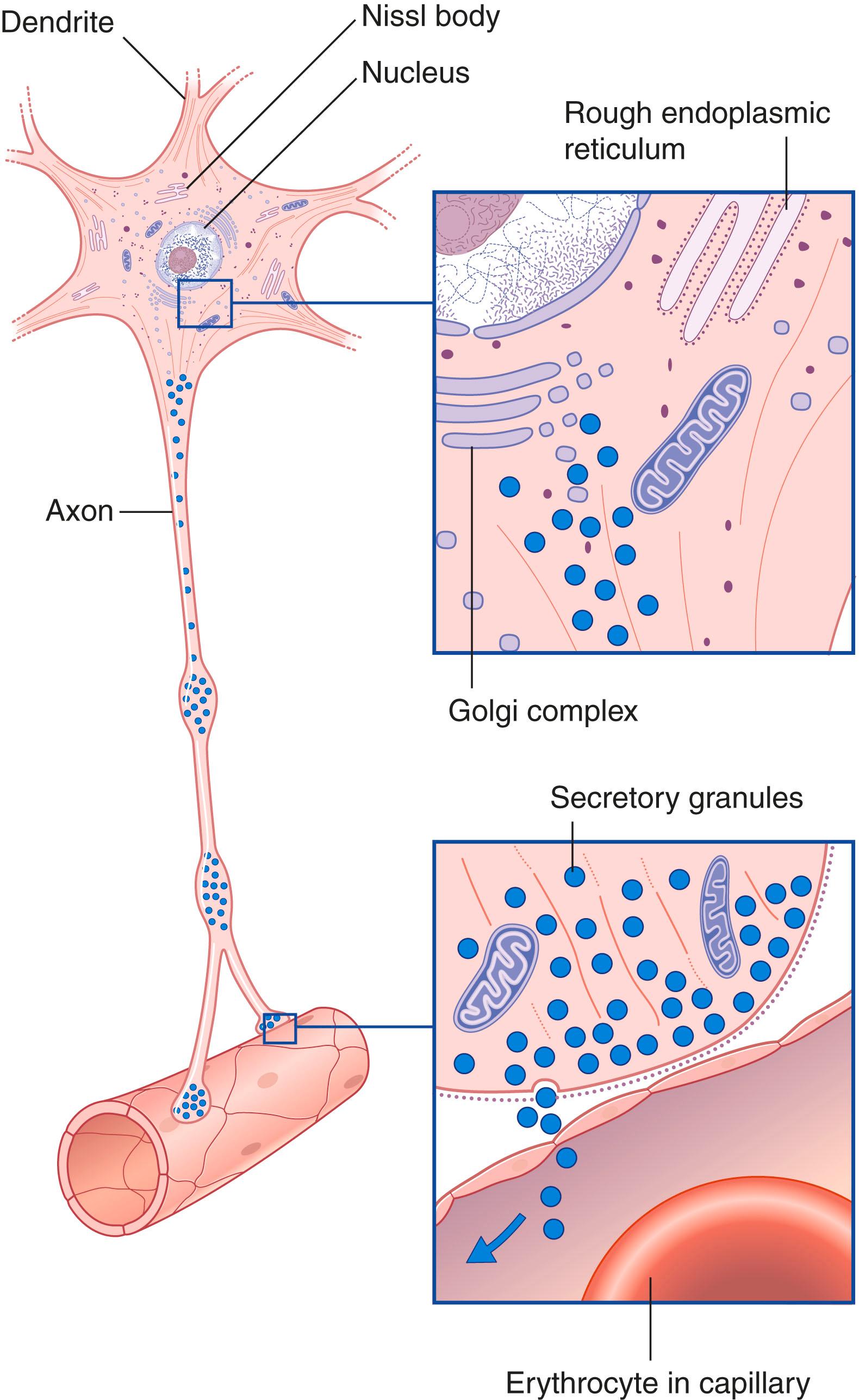Physical Address
304 North Cardinal St.
Dorchester Center, MA 02124
The pituitary gland (hypophysis cerebri) is in the hypophyseal fossa of the sphenoid bone and is intimately linked to the hypothalamus. It is composed of two parts: the adenohypophysis and the neurohypophysis.
Hypothalamic neuroendocrine cells fulfil the basic criteria both for neurons and for endocrine cells. Small neuroendocrine cells control release of hormones by the purely endocrine cells of the anterior pituitary gland. Large neuroendocrine cells have their terminals in the posterior pituitary, where they release hormones directly.
Some neurons confined to the hypothalamus are involved in control of body temperature, food and fluid intake, and sleep. Others, involved in attack and defence responses, and memory, are controlled by the limbic system.
The hypothalamus develops as part of the limbic system, which is concerned with preservation of the individual and of the species. Therefore, it is logical that the hypothalamus should have significant controls over basic survival strategies, including reproduction, growth and metabolism, food and fluid intake, attack and defence, temperature control, the sleep–wake cycle, and aspects of memory.
Most of its functions are expressed through its control of the pituitary gland and of both divisions of the autonomic nervous system.
The hypothalamus occupies the side walls and floor of the third ventricle. It is a bilateral, paired structure. Despite its small size (it weighs only 4 g), it has major functions in homeostasis and survival. Its homeostatic functions include control of body temperature and circulation of blood. Its survival functions include regulation of food and water intake, the sleep–wake cycle, sexual behaviour patterns, and defence mechanisms against attack.
The boundaries of the hypothalamus are as follows ( Figs. 34.1 and 34.2 ):
Superior : the hypothalamic sulcus separating it from the thalamus
Inferior : the optic chiasm , tuber cinereum , and mammillary bodies . The tuber cinereum shows a small swelling, the median eminence , immediately behind the infundibulum (‘funnel’) atop the pituitary stalk
Anterior : the lamina terminalis
Posterior : the tegmentum of the midbrain
Medial : the third ventricle
Lateral : the internal capsule


In the sagittal plane, it is customary to divide the hypothalamus into three regions: anterior (supraoptic), middle (tuberal), and posterior (mammillary). These areas are small, even in large mammals, and the descriptive use of ‘regions’ has been convenient for animal experiments involving placement of lesions and often serves us well in the clinical setting with humans. Named nuclei in the three regions are listed in Table 34.1 .
| Location | Nucleus | Function |
|---|---|---|
| Posterior | Posterior |
|
| Mammillary | Memory | |
| Tuberomammillary | Arousal/sleep, memory/learning, energy, balance | |
| Middle | Paraventricular |
|
| Dorsomedial | Heart rate, blood pressure, GI stimulation | |
| Lateral |
|
|
| Ventromedial | Satiety, thermoregulation, and sexual activity | |
| Arcuate |
|
|
| Anterior | Preoptic | Gonadotrophin releasing hormones, thermoregulation |
| Supraoptic | Vasopressin and oxytocin | |
| Suprachiasmatic | Circadian rhythms |
In the coronal plane, the hypothalamus can be divided into lateral , medial , and periventricular regions. The full length of the lateral region is occupied by the lateral hypothalamic nucleus . Merging with the lateral nucleus is the medial forebrain bundle , carrying aminergic fibres to the hypothalamus and to the cerebral cortex.
The pituitary gland (hypophysis cerebri) is in the hypophyseal fossa of the sphenoid bone and is intimately linked to the hypothalamus.
All endocrine glands have a rich vascular supply, to satisfy the high energy needs of the endocrine cells, but the veins and capillaries are the ductal system for hormone secretion.
The pituitary consists of two distinct parts:
The anterior adenohypophysis, which arose embryonically from the roof of the primitive pharynx, is composed of glandular cells. There are two regions, the tuberal or infundibular part which is a narrow extension of cells from the main region the anterior pars distalis. Trophic hormone secreting gland cells can be classified into chromophobes and chromophils depending on staining affinity. Further classification of cell type is dependent upon staining characteristics, often using immunocytochemistry.
The key glandular cell types (and hormonal products) found within the adenohypophysis include: somatotrophs (growth hormone), mammotrophs (prolactin), gonadotrophs (follicle stimulating hormone (FSH) and luteinizing hormone (LH)), thyrotrophs (thyrotrophin), and corticotrophs (adrenocorticotrophic hormone (ACTH)).
The second part of the pituitary gland is the posterior neurohypophysis, which is formed from a downgrowth from the floor of the third ventricle and is composed of nerve fibres and nerve endings. The neurohypophysis continues superiorly as the pituitary stalk (infundibulum) above the subarachnoid space at the base of the brain. The nerves contained are neurosecretory fibres originating in the supraoptic and paraventricular nuclei of the hypothalamus, releasing the hormones oxytocin and vasopressin (antidiuretic hormone (ADH)).
The arterial supply of the pituitary gland comes from hypophyseal branches of the internal carotid artery ( Fig. 34.3 ). One set of branches supplies a capillary bed in the wall of the infundibulum. These capillaries drain into portal vessels , which pass into the adenohypophysis (anterior lobe). There they break up to form a second capillary bed, which bathes the endocrine cells and drains into the cavernous sinus.

The neurohypophysis receives a direct supply from the inferior hypophyseal arteries. The capillaries drain into the cavernous sinus, which delivers the secretions of the anterior and posterior lobes into the general circulation.
Secretions of the pituitary gland are controlled by two sets of neuroendocrine cells . Neuroendocrine cells are true neurons in having dendrites and axons and in conducting nerve impulses. They are also true endocrine cells because they liberate their secretions into capillary beds ( Fig. 34.4 ). With one exception (mentioned below), the secretions are peptides, synthesised in clumps of granular endoplasmic reticulum and packaged in Golgi complexes. The peptides are attached to long-chain polypeptides called neurophysins . The capillaries concerned are outside the blood–brain barrier and are fenestrated.

The somas of the neuroendocrine cells occupy the hypophysiotropic area in the lower half of the preoptic and tuberal regions. Contributory nuclei include the preoptic , supraoptic , paraventricular , ventromedial , and arcuate (infundibular). Two classes of neurons can be identified: parvocellular (small) neurons reaching the median eminence and magnocellular (large) neurons reaching the posterior lobe of the pituitary gland.
Become a Clinical Tree membership for Full access and enjoy Unlimited articles
If you are a member. Log in here